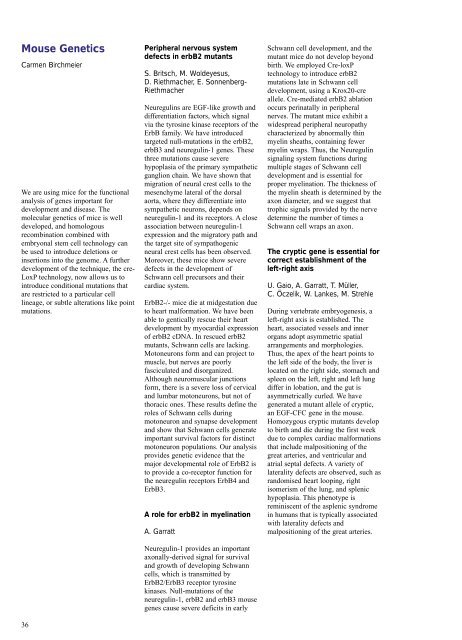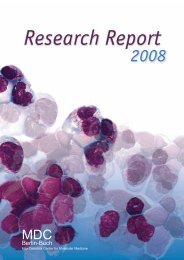You also want an ePaper? Increase the reach of your titles
YUMPU automatically turns print PDFs into web optimized ePapers that Google loves.
Mouse Genetics<br />
Carmen Birchmeier<br />
We are using mice for the functional<br />
analysis of genes important for<br />
development and disease. The<br />
molecular genetics of mice is well<br />
developed, and homologous<br />
recombination combined with<br />
embryonal stem cell technology can<br />
be used to introduce deletions or<br />
insertions into the genome. A further<br />
development of the technique, the cre-<br />
LoxP technology, now allows us to<br />
introduce conditional mutations that<br />
are restricted to a particular cell<br />
lineage, or subtle alterations like point<br />
mutations.<br />
36<br />
Peripheral nervous system<br />
defects in erbB2 mutants<br />
S. Britsch, M. Woldeyesus,<br />
D. Riethmacher, E. Sonnenberg-<br />
Riethmacher<br />
Neuregulins are EGF-like growth and<br />
differentiation factors, which signal<br />
via the tyrosine kinase receptors of the<br />
ErbB family. We have introduced<br />
targeted null-mutations in the erbB2,<br />
erbB3 and neuregulin-1 genes. These<br />
three mutations cause severe<br />
hypoplasia of the primary sympathetic<br />
ganglion chain. We have shown that<br />
migration of neural crest cells to the<br />
mesenchyme lateral of the dorsal<br />
aorta, where they differentiate into<br />
sympathetic neurons, depends on<br />
neuregulin-1 and its receptors. A close<br />
association between neuregulin-1<br />
expression and the migratory path and<br />
the target site of sympathogenic<br />
neural crest cells has been observed.<br />
Moreover, these mice show severe<br />
defects in the development of<br />
Schwann cell precursors and their<br />
cardiac system.<br />
ErbB2-/- mice die at midgestation due<br />
to heart malformation. We have been<br />
able to gentically rescue their heart<br />
development by myocardial expression<br />
of erbB2 cDNA. In rescued erbB2<br />
mutants, Schwann cells are lacking.<br />
Motoneurons form and can project to<br />
muscle, but nerves are poorly<br />
fasciculated and disorganized.<br />
Although neuromuscular junctions<br />
form, there is a severe loss of cervical<br />
and lumbar motoneurons, but not of<br />
thoracic ones. These results define the<br />
roles of Schwann cells during<br />
motoneuron and synapse development<br />
and show that Schwann cells generate<br />
important survival factors for distinct<br />
motoneuron populations. Our analysis<br />
provides genetic evidence that the<br />
major developmental role of ErbB2 is<br />
to provide a co-receptor function for<br />
the neuregulin receptors ErbB4 and<br />
ErbB3.<br />
A role for erbB2 in myelination<br />
A. Garratt<br />
Neuregulin-1 provides an important<br />
axonally-derived signal for survival<br />
and growth of developing Schwann<br />
cells, which is transmitted by<br />
ErbB2/ErbB3 receptor tyrosine<br />
kinases. Null-mutations of the<br />
neuregulin-1, erbB2 and erbB3 mouse<br />
genes cause severe deficits in early<br />
Schwann cell development, and the<br />
mutant mice do not develop beyond<br />
birth. We employed Cre-loxP<br />
technology to introduce erbB2<br />
mutations late in Schwann cell<br />
development, using a Krox20-cre<br />
allele. Cre-mediated erbB2 ablation<br />
occurs perinatally in peripheral<br />
nerves. The mutant mice exhibit a<br />
widespread peripheral neuropathy<br />
characterized by abnormally thin<br />
myelin sheaths, containing fewer<br />
myelin wraps. Thus, the Neuregulin<br />
signaling system functions during<br />
multiple stages of Schwann cell<br />
development and is essential for<br />
proper myelination. The thickness of<br />
the myelin sheath is determined by the<br />
axon diameter, and we suggest that<br />
trophic signals provided by the nerve<br />
determine the number of times a<br />
Schwann cell wraps an axon.<br />
The cryptic gene is essential for<br />
correct establishment of the<br />
left-right axis<br />
U. Gaio, A. Garratt, T. Müller,<br />
C. Öczelik, W. Lankes, M. Strehle<br />
During vertebrate embryogenesis, a<br />
left-right axis is established. The<br />
heart, associated vessels and inner<br />
organs adopt asymmetric spatial<br />
arrangements and morphologies.<br />
Thus, the apex of the heart points to<br />
the left side of the body, the liver is<br />
located on the right side, stomach and<br />
spleen on the left, right and left lung<br />
differ in lobation, and the gut is<br />
asymmetrically curled. We have<br />
generated a mutant allele of cryptic,<br />
an EGF-CFC gene in the mouse.<br />
Homozygous cryptic mutants develop<br />
to birth and die during the first week<br />
due to complex cardiac malformations<br />
that include malpositioning of the<br />
great arteries, and ventricular and<br />
atrial septal defects. A variety of<br />
laterality defects are observed, such as<br />
randomised heart looping, right<br />
isomerism of the lung, and splenic<br />
hypoplasia. This phenotype is<br />
reminiscent of the asplenic syndrome<br />
in humans that is typically associated<br />
with laterality defects and<br />
malpositioning of the great arteries.

















